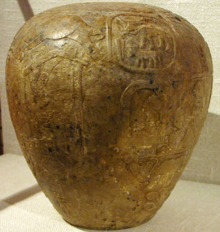- Naos (shrine)
-


Shrine (Naos)-O18
(O21-rectangular)
in hieroglyphsA naos (Greek for temple) was the sanctuary, the innermost chamber, of a Greek temple, in Latin referred to as cella.
The Apostle Paul in the New Testament uses this word in 1 Corinthians 3:16 and 2 Corinthians 6:16 to denote that the bodies of the Christians are the Most Holy Places of the Living God as He indwells them (Exodus 40:35). The word is nowadays used for temple sanctuaries of many ancient cultures.[1] In Egyptian language hieroglyphs, two common versions exist, the oldest starting in the Old Kingdom era, then a common rectangular form from the New Kingdom and later.
Contents
In Egyptology
The Narmer Macehead, left of centre the naos with Narmer sitting in it
The naos as a small shrine is known in its typically Egyptian form since the beginning of Ancient Egyptian history. It eventually came to be represented as an Egyptian hieroglyph.
Some of the oldest examples are from the labels of the early pharaohs. Pharaoh Narmer is shown on the Narmer Macehead seated in a naos.
A statue of a person holding a little naos, such as the statue of the Ramesside overseer of the treasury Panehsy, is called naophorous.[2] The earliest examples of such statues date to the 18th dynasty.[3]
Naos-doubled, the Pavilion hieroglyph
The pavilion hieroglyph is a side view of the pharaoh seated, in opposing views, wearing the two separate crowns, the crown of the South, the white crown, and the crown of the North (the Delta), the red crown. The pavilion is composed of two side views of the naos (hieroglyph), Gardiner no. O18.
The early Old Kingdom labels, for example Pharaoh Den, portrayed him in a side view in his naos shrine. An example of the combined, opposed, view with the two crowns, is the lintel of Senusret II, 12th dynasty, 19th century BC. It shows the naos curved roofs of each half of the pavilion hieroglyph.
References
- ^ Concise Oxford Dictionary, Oxford University Press, 10th edition, p.947
- ^ Elizabeth Frood, John Baines, Biographical Texts from Ramessid Egypt, Society of Biblical Literature, 2007, ISBN 1589832108, p.166
- ^ Jacques Vandier, Manuel d'archéologie égyptienne, A. et J. Picard 1952, p.68
See also
- Gardiner's Sign List#O. Buildings, Parts of Building, etc.
- Jubilee Pavilion (hieroglyph)
Categories:- Ancient Egypt stubs
- Egyptian artefact types
- Egyptian hieroglyphs
- Egyptian hieroglyphs: buildings and parts-of-buildings-etc
- Egyptian hieroglyphs-Gardiner listed
Wikimedia Foundation. 2010.
